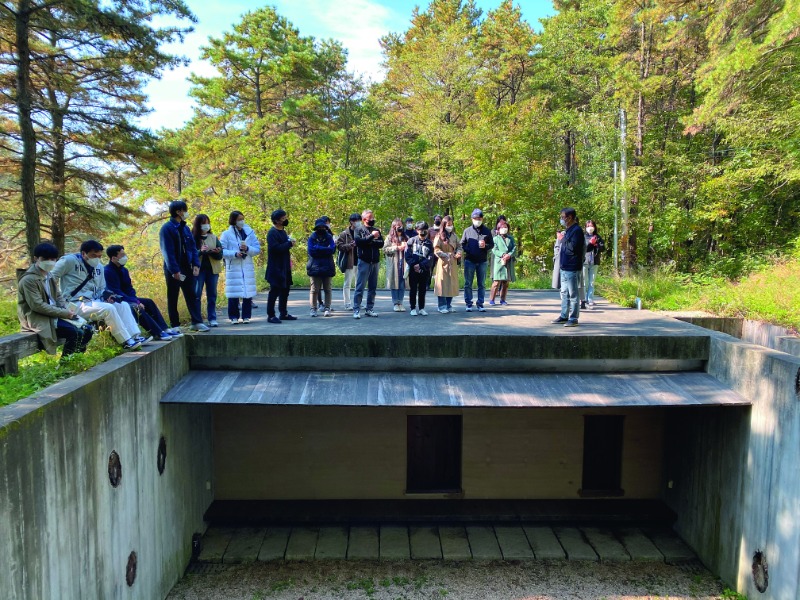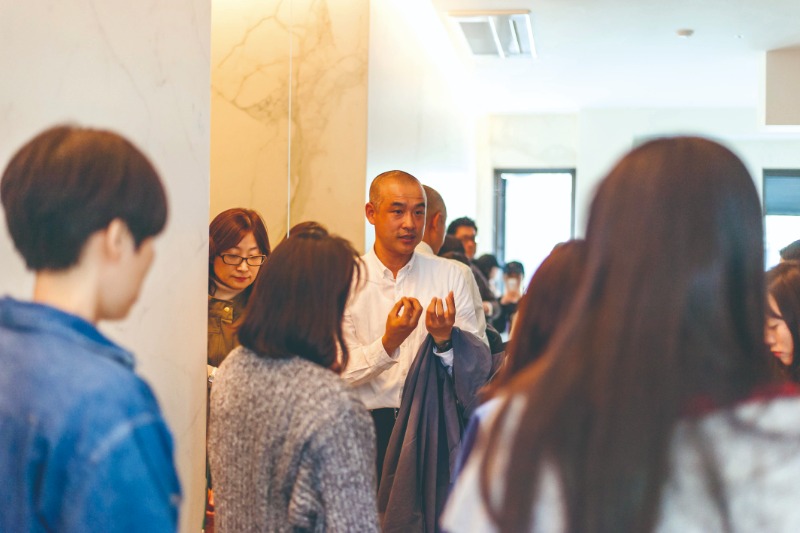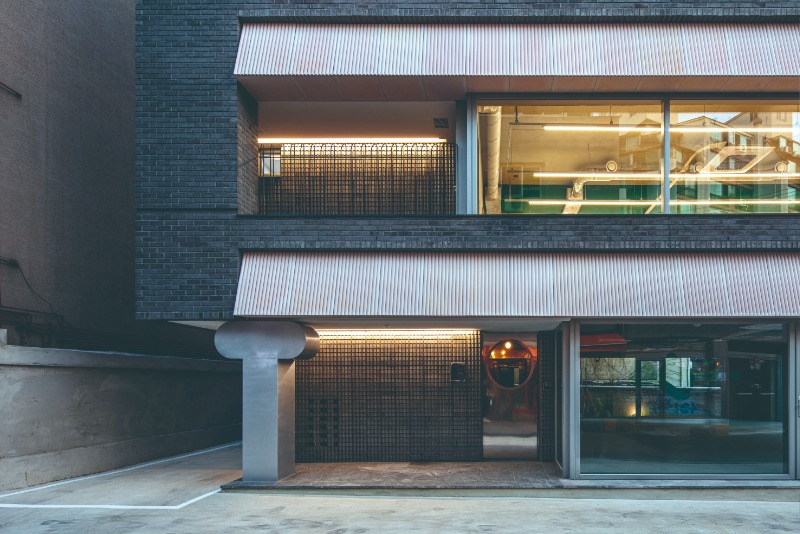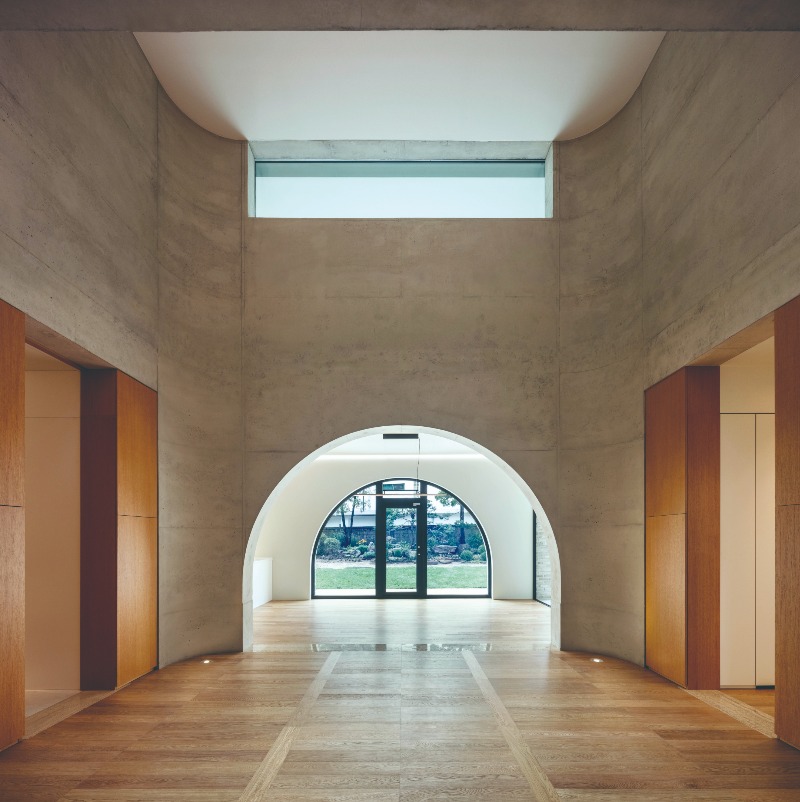Once considered a difficult subject, architecture is now carving out a place on the cultural menu. People watch TV shows where the hosts shop around for homes to match clients’ tastes and needs, and use apps to look inside other people’s houses to gain ideas for design and buying interior products. As general interest in the built environment grows, architects in their 30s and 40s are gaining a greater appreciation of what has been built and what is possible.

Visitors look at the inside of a house in Yangpyeong County, Gyeonggi Province, that participated in OPENHOUSE Seoul 2020. This house that looks as if it was dug into the ground was designed by renowned architect Cho Byoung-soo in honor of the poet and independence fighter Yoon Dong-ju (1917–1945), in the spirit of the poet’s anthology Sky, Wind, and Stars.
© OPENHOUSE Seoul
Decades ago, when a large supply of standardized housing units was built to ease a housing shortage in Korea, there was no basic education or understanding of how to approach architecture from a cultural and artistic point of view. Architecture was generally perceived as a difficult subject. Unlike music or literature, it could not easily be enjoyed anywhere, anytime, and it required a much greater financial outlay than a good meal.
It remains difficult to understand or appreciate the design or functionality of a private house or building without actually being invited inside. But in 2017, the TV show “The Dictionary of Useless Knowledge: Season 2,” aired on tvN, began to open doors. Exploring travel destinations across Korea, panelists on the show talked about different cities’ literature, food, science, and other matters in connection with stories of architecture and the respective cities’ evolution. In doing so, they reinterpreted architecture from a unique perspective and satisfied the curiosity of young viewers.

OPENHOUSE Seoul, an urban architecture festival held every October, admits ticket holders who want a first-hand look at the artistic, environmental, and architectural aspects of places that are normally closed to the public. .
© Lee Gang-seok (Courtesy of OPENHOUSE Seoul)
Yoo Hyun-joon, an architect who appeared on the show, saw the number of subscribers to his YouTube channel surpassing 740,000 by the end of the show’s first year. His rise to fame proved that architecture could be an attractive subject for media content. Other programs, such as “A Study of Architecture — Houses” on EBS and “Where is My Home” on MBC, jumped on the bandwagon and garnered high viewership ratings, too.
OPENHOUSE Seoul, an architecture festival held in October every year, has also attracted great attention by allowing people inside places that are usually inaccessible. The festival was launched in Seoul in 2014 at the initiative of Lim Jin-young, an architectural journalist who was inspired by similar festivals in Western countries. OPENHOUSE Seoul has now become so popular that online bookings close almost as soon as they open. The festival introduces houses, office buildings, cultural and religious spaces, and cultural properties as well as factories and other types of urban architecture. Those who gain a ticket of admission also have the opportunity to meet the architect of the building or site they are visiting.
Experiencing architecture firsthand is a trend whose current prevalence owes much to social media, which is focused on visual information. Skeptics may say that in today’s culture, where people create online personas predominantly through posting selfies, interest in architecture may simply be driven by the fear of missing the chance to experience a trend and post pictures. As it turns out, however, visitors to places actually want to know who designed them, not just be seen. This suggests an unprecedented level of genuine interest, and the names of select architects are now akin to brands. Instagram popularity has even helped some architects win new projects. For their part, architects sometimes optimize their designs not so much for pretty pictures or that definitive shot that sells but for Instagram. “Instagrammable” is now so well-established a concept that the term has been added to the Cambridge Dictionary.
NEIGHBORHOODS REDISCOVERED

The Seogyo Geunsaeng Residential Building in Seoul’s Mapo District is characterized by awnings that can be seen on any Korean neighborhood store.
© Chin Hyo-sook
The current climate has prompted architects to rethink their profession. Architects in their 30s and 40s are cultivating more and more interest in things Korean, including places in the provinces. Their appreciation for Korean architecture has developed from within, however, rather than being generated by enthusiasm outside the country, like K-pop or other “K” trends. This generation of architects learned Western architecture through media or by studying abroad. But as they began applying Western designs and methods to their own projects, many realized that the local milieu for building differed in profound ways — the climate, building materials, project budgets, cultural background, legal provisions, and of course people’s tastes.
First, they began to focus on what was in front of them. As a result, many architects rediscovered multiplex and multi-dwelling housing, both built on a large scale in the 1970s and 1980s. In stark contrast to cultural properties or high-end buildings, these plain red-brick housing units, with their brown window frames and thin metal gates, previously received hardly a second glance from highly educated architects. Once slighted as mass-produced homes for middle-income families based on a single blueprint, they are now regarded both as urban assets and precious mementos of neighborhoods that are fast disappearing to make way for new apartment complexes. Though built somewhat randomly with little concern for artistry, there are traces of design improvised by construction workers when necessary. Architects now are fascinated by the impromptu creativity that workers must have used under limited conditions.
Such obscure buildings are recorded with sophisticated drawings by architect Kwon Tae-hoon in his books Façade Seoul and Villa Sash. Other innovative examples using traditional architectural characteristics include the Seogyo Geunsaeng Residential Building in Mapo-gu, Seoul, designed by Suh Jae-won, who chose concrete for the building’s awnings; Jeomchon Gi-Wa House, a modern building with traditional roof tiles in Mungyeong, designed by Kim Hyo-young; and the Cheongun Residence, a house with audacious arched doorways in the building’s titular neighborhood in Seoul, designed by Kim Hyundai+Tectonics Lab. It is no coincidence that many other new buildings in Korea also feature brickwork.
PRAGMATIC BUYERS

The Cheongun Residence near downtown Seoul boasts archways and characteristics of modern Korean architectural style.
© Tectonics Lab
In the past, homeowners liked to boast of more obvious features, such the shape of the house, interiors finished with imported materials, and rooms with large windows. But the current view stresses practicality and solid value for money over aesthetics. Pragmatic people are now willing to pay for eco-friendly construction materials, speedy but efficient construction techniques, energy efficiency, air quality, and other less visible factors.
During much of the year, it is not practical to open windows in Korea because of the hot, humid summers and freezing winters. Keeping rooms comfortable means keeping windows closed to maximize insulation efficiency and minimize energy waste when cooling and heating. In this situation, more home buyers are making choices based on concrete data such as energy consumption and indoor air density and quality.
We are directly affected by a number of real-life challenges, including severe climate change and the resulting greater emphasis on clean energy, as well as economic turmoil and the impact of the fourth industrial revolution. This also means that our attitude towards architecture will keep changing.
Bae Yoon-kyung Architectural Columnist and Visiting Professor of Architecture at Dankook University